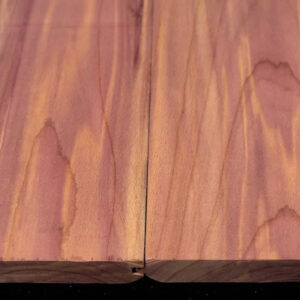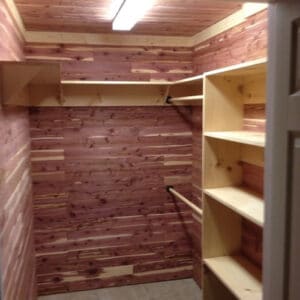Description
Cedar Lap Siding for Indoor/Outdoor applications
- Made from Durable 6″ and 8″ Wide Eastern Red Cedar
- Approximately 5/8″ Thick Eastern Red Cedar Lumber
- 8 Foot Boards Only
- Rough Finish Only
- Minimum order: 125 boards
Beveled Lap Cedar Siding:
There is no substitute for the natural beauty and durability of Eastern Red Cedar siding. Eastern Red Cedar gives your home a level of warmth and beauty that you can’t get with plastic home siding options. Eastern Red Cedar is also naturally resistant to rot, decay and insect attacks. Unlike cedar, plastic house siding doesn’t have any natural defenses against things like mildew. In addition, composite siding is susceptible to fading due to sun exposure and can’t be restored or refinished like cedar once their color has faded.
Real cedar siding is one of the most sustainable exterior siding available. It produces the least greenhouse gas, air pollution, water pollution and solid waste. Not only that — Eastern Red Cedar lumber is harvested from the most sustainably managed forests in the world. So you can feel good about your wood.
Eastern Red Cedar is free of pitch and resin, which means it takes to stains, oils and finishes very well. As a result, you have a lot of siding color options. The same goes for the style options. For example, you can go for the warm traditional feel of layered bevel or you can streamline your home’s look with some super sleek, tongue and groove siding or you can get creative with your own board and batten pattern.
- Dehumidified, Never Kiln Dried - Most, if not all, companies that ship Eastern Red Cedar will always kiln dry their products. When kiln dried, they takes the moisture content down to around 10-12%. This makes the wood lighter and saves money on shipping. Unfortunately, it also reduces the amount of cedar oils in the wood limiting the natural benefits and the very reason you are installing a cedar closet. Our de humidification chamber dries the cedar perfectly to maintain the wood’s natural scent, fiber texture, and color.
- 5/8 Inch Thickness - This means that you will get twice the amount of cedar oil in your closet liner panels! It's the cedar oil that gives your closet that special cedar aroma that naturally and safely repel common household insects including moths, cockroaches, and silverfish. When you couple the facts that our boards are twice as thick as our nearest competitor with our proprietary drying process that retains the most amount of cedar oil, it's easy to see that our cedar closet liners are just better, and why they will last longer.
- Cut Fresh - There is no place we have found, or know of, that will custom cut, and ship, 1/2 inch aromatic eastern cedar wood for closet liners. When we started this business our goal was to help everyday people, with or without carpentry skills, who want to easily install the best cedar closet lining with the least amount of work. Ten years later, and thanks to our wonderful customers, we are the webs #1 seller, and shipper, of custom cut 1/2 inch aromatic eastern red cedar closet liners.
- Appearance Grade Cedar -Cedar is graded based on Appearance, which is called "appearance grade" or Select Lumber. Appearance grade is primarily for non-structural lumber under 2" thick. Appearance grades use letters A through D, with A being the highest grade. All of the cedar that we sell for closet liners is A grade Appearance Board eastern red cedar.

| Specification | Detail |
|---|---|
| Approx. Pre-Planing Length | 8' Feet |
| Thickness (in.) | Approx. 1/2″ Thick |
| Width (in.) | Approx 6" or 8" inches |
| Board Joint Type | Square Edge |
| 1 Board Covers Approx. | Approx. 3.5'sf OR Approx. 5'sf |
| Finish Type | None |
| Is Returnable | No |
| Lumber Grade | Appearance Board |
| Moisture content | Dehumidified |
| Saw Cut | Rough |
- All advertised sizes are approximate.
- Due to custom cutting & milling there are no refunds.
- We Offer Free Shipping on Many Items
- Free t-Shirt on all orders over $400.00
- Got a Question? No Problem! Call toll-free for Ordering Support 1-800-422-9912.
How to Install Cedar Bevel Siding

Cedar is a popular siding material for houses, especially in the western United States where that wood is plentiful. Cedar resists rot and decay and most insect infestations, so it is both attractive and durable. It can be stained in many shades or can be painted, although most cedar siding is left natural.
There are several types of cedar siding, but a standard option is beveled, angled so the bottom of the board is thicker than the top, to produce a natural flow of rainwater down the wall and protect against seepage into joints between boards.
- Wrap the house with a polyethylene or similar moisture barrier, stapled to the wooden wall sheathing with a construction stapler. Seal seams with a matching tape.
- Install corner trim on all corners, typically 1-by-4-inch boards nailed vertically, with the wide face of a board facing the street side of the house and overlapping the edge of the adjoining board. Use a level to set the trim plumb on both walls. Nail the trim with a hammer and galvanized nails. Extend it from the roof line to the bottom of the wall.
- Fasten a cedar starter strip the same thickness as the top of the beveled siding all around the house, using a tape measure and level to set it level along the bottom of the wall. Secure it to the bottom of the house sheathing with a hammer and galvanized nails long enough to penetrate the sheathing into the bottom plate of the wall by 1 1/4 inches.
- Set the first bevel board in place against the trim at a corner of the house. Align the bottom of the bevel plank with the bottom of the starter strip, with the end flush against the trim, and use a 4-foot level to level it. Fasten the plank with galvanized ring shank nails long enough to penetrate the siding, sheathing and into the wall studs at least 1 1/4 inch. Drive nails through the bottom of the board, about 1 inch above the edge, one nail in each stud, 16 inches apart.
- Nail on a second plank abutting the first. using a level to set it level. Work to the end of the house, adding planks. Cut a plank to fit at the end, trimming it to butt against the trim board.
- Start a second layer with a partial board so the siding seams do not align; use the piece cut off from the first layer if possible. Overlap the bottom of the second board 1 inch over the top of the first layer and fasten it with nails high enough to miss the top of the underlying board, usually about 1 1/2 inches up the plank. Use a level to keep the plank level.
- Work around and up the house, taking care to keep planks equal at corners on both sides; some installers run courses around the house to maintain this level, rather than nailing boards up a whole wall at one time. Work in layers as an alternative: nail on two or three courses on one wall, then work around the house matching those layers for level before starting over.
- Cut boards with a table or circular saw where necessary to fit around walls or windows. Measure openings carefully to notch out or cut holes with a hole saw or jigsaw for dryer vents, plumbing pipes, electrical outlets or other protrusions. Use long pieces of siding under windows, so the cutout is in the center of a plank and there are no butt joints under the window. Do the same at the tops of windows or doors.
- Cover the walls with beveled siding to the roof line. Trim the last planks if necessary by ripping off the tops with a table saw. Allow a gap of about 1/4 inch between the top of the last board and the soffit at the top of the wall. Seal that gap with molding to match the corner trim; trim pieces can be cedar like the siding or smooth-finished pine or cedar boards.
We Only Sell Aromatic Eastern Red Cedar
Our cedar panels can be used for closet liners, V-paneling and flooring. Our dehumidification chamber dries the cedar perfectly to maintain the wood’s natural scent, fiber texture, and color.
Eastern Red Cedar (Juniperus Virginiana) is extremely resistant to and repels many types of pests, such as rodents, roaches and termites. Please take note: that most cedar products on the market are Western Cedar. Our Eastern Cedar products offer better durability and insect repellents. Not even carpenter bees will want to bore into our wood!
Red Cedar is not only a beautiful, durable wood, but it also has an AMAZING scent! This type of wood was commonly used by noblemen, royalty and Native Americans (Cherokee Indians) in both modern and Biblical times. All of our wood is hand-selected premium grade planed Red Cedar. Our flooring, trim, and lap-siding products can be used for closet liners, churches, basements, garages, tiny homes, log homes, tree houses and much more.
We also sell Cedar Siding products to fit your needs. There are an assortment of Cedar Shakes in various shapes and sizes available for your selection. Lap siding is also available in our store. Our Products can be used for interiors and exteriors. Use as Siding, Paneling, Flooring, and more!
| Attribute | Detail |
|---|---|
| Common Name | Aromatic Red Cedar, Eastern Redcedar |
| Scientific Name | Juniperus virginiana |
| Distribution | Eastern North America |
| Tree Size | 100-115 ft (30-35 m) tall, 3-4 ft (1-1.2 m) trunk diameter |
| Average Dried Weight | 33 lbs/ft3 |
| Specific Gravity | 44, .53 |
| Janka Hardness | 900 lbf (4,000 N) |
| Color/Appearance | Heartwood tends to be a reddish or violet-brown. Sapwood is a pale yellow color, and can appear throughout the heartwood as streaks and stripes. |
| Grain/Texture | Has a straight grain, usually with knots present. Has a very fine even texture. |
| Endgrain | Resin canals absent; earlywood to latewood transition gradual, grain moderately uneven to moderately even; tracheid diameter small to very small; zonate parenchyma (double ring). |
| Rot Resistance | Regarded as excellent in resistance to both decay and insect attack, Aromatic Red Cedar is frequently used for fence posts used in direct ground contact with no pre-treating of the wood. |
| Workability | Overall, Aromatic Red Cedar is easy to work, notwithstanding any knots or irregularities present in the wood. It reportedly has a high silica content, which can dull cutters. Aromatic Red Cedar glues and finishes well, though in many applications, the wood is left unfinished to preserve its aromatic properties. |
| Odor | Aromatic Red Cedar has a distinct and tell-tale scent: the wood is commonly used in closets and chests to repel moths and other insects. |
| Common Uses | Fence posts, closet and chest linings, carvings, outdoor furniture, birdhouses, pencils, bows, and small wooden specialty items. |
About Red Cedar
Eastern red cedar grows in the eastern part of the United States, typically ranging between 20′-100′. Sometimes referred to as “aromatic cedar,” this cedar is known for its pungent scent from its natural oils. This cedar’s exterior boasts a reddish-violet tinted brown, while its inner sapwood appears pale yellow. The sapwood often makes an appearance throughout the heartwood.
The terms “red cedar” and “aromatic cedar” are markedly different in their context. Red cedar is a lay, or common, term. In a scientific context, the taxonomical names of trees -- Thuja plicata and Juniperus virginiana -- are used. Aromatic cedar, on the other hand, is a trade term used by carpenters, contractors and other professionals in the building trade.
The term refers specifically to the lumber of the eastern red cedar. It differs from the term “red cedar” in that red cedar refers to the tree as a whole, while “aromatic cedar” specifically denotes the wood of the eastern red cedar that is used in building projects and sometimes only building project lumber culled from specimens of eastern red cedar found in the southern portions of the Appalachian Mountains.
Conifer. Height 40 to 60 feet. Trunk diameter 2 to 4 feet. Usually a small tree, it has been known to grow 90 feet high with a trunk circumference of 13 feet. Distribution; Nova Scotia south to Georgia along the Atlantic Coast west to the Mississippi River states. It is the state tree of Tennessee. The eastern or "aromatic" red cedar is the species used for moth-proof storage chests and clothes closets. It is not to be confused with the huge timber species of the west coast: western red cedar and incense cedar.
A firm, stable softwood, the timber of this red cedar is highly prized for its beautiful, warm, deep, rich, red color and its most distinctive, everlasting, aromatic perfume. The wood is light and easy to work. It has numerous knots that make a handsome distinctive pattern. Otherwise it is straight and close grained. Due to its natural beauty and scent, it is never painted or stained. The wood is enduring - it is strong and durable. Its natural oils contain the secret of its success
Where aromatic red cedar is concerned, the knottier the wood the better. The many knots indicate the exceptionally high content of the aromatic oils that distinguish this wood from all others. The more oil the stronger the scent; the stronger the scent the deader the moth! (And, of course, the more wonderful smelling the stored woolen clothes.) This same oil makes cedar decay and insect resistant and waterproof; the perfect wood of choice for long term use. The wood also has low shrinkage and is very stable once applied.
Despite its relatively high cost, aromatic red cedar is worth the cost for the service it performs. It is typically available as veneer and lumber. The trunks of the majority of this red cedar are used for fence posts. The water resistant lumber is used in greenhouse construction and for window sills and small boat decks.
It is most commonly associated with cedar blanket chests, wardrobes, clothes closet interiors, storage room paneling and dresser drawer linings. It is also used for scientific instruments and novelties. The pencil in your hand or behind your ear is made of red cedar woods. This soft but firm, straight, close-grained wood is designed to sharpen perfectly and easily. Also, the shavings smell nice. Isn't nature grand!
Have Questions?
Please give us a call, or shoot us a line and we will be happy to help you with your project or concerns.
(800) 422-9912









